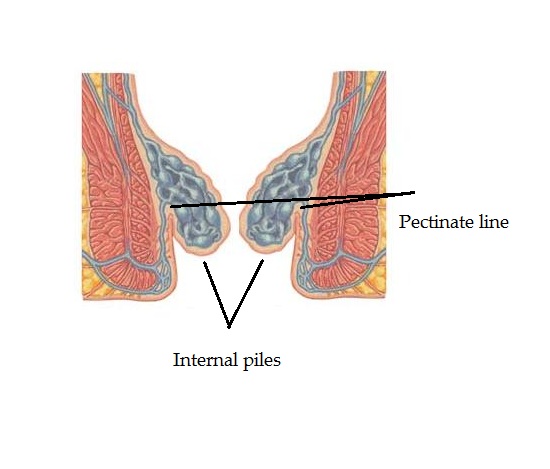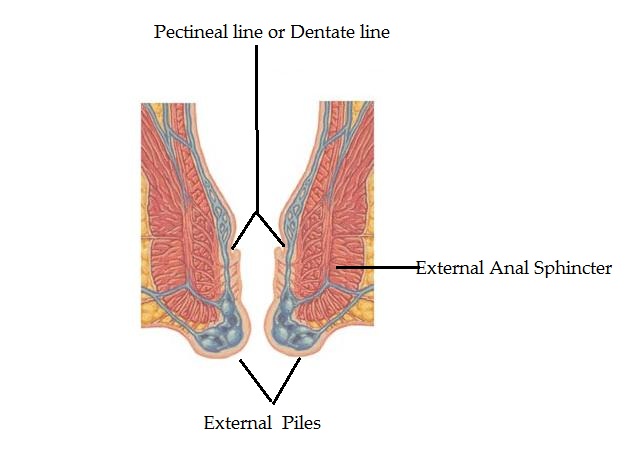Hemorrhoids
Definition
Haemorrhoids are dilated veins occurring in relation to the anus.
Types of Hemorrhoids
external
internal
External variety is covered by skin
The internal variety is covered by mucous membrane.
When both are present together - called intero-external haemorrhoids.
Pathophysiology
Pile mass (dilated veins) descends - gripped by the sphincters - more engorgement
Mucosal gatherings in relation to the three branches of superior rectal arteries are called anal cushions - necessary for continence
They slide down and internal haemorroids develop in the prolapsing tissues.
Aetiology
Heredity - congenital weakness of vein walls
An abnormally large arterial supply to the rectal plexus.
Varicose veins of the legs and haemorrhouds often occur concurrently
Most are idiopathic
Carcinoma rectum
Pregnancy
Straining at micturition
The superior rectal veins being tributaries of the portal vein have no valves.
Straining accompanying constipation or that induced by overpurgation
Diarrhoea of enteritis, colitis or the dysenteries aggravates the latent haemorrhoids
Internal Hemorrhoids
Commonest.
Internal haemorrhoids are arranged in three groups at 3,7, and 11 O'clock positions during (in lithotomy position)
It is bright red or purple
An external haemorrhoid - blue veins can be seen - skin color
Clinical Features
Symptoms of haemorhhoids :-
Bright red (although from veins), painless bleeding
Mucus discharge
Prolapse of a mass
Pain only on prolapse
Anaemia
Investigations
External haemorrhoid is visible on inspection itself - Redundant folds or tags of skin
On straining the internal haemorrhoids may become visible transiently
Proctoscopy
Digital examination - if thrombosed felt
Sigmoidoscopy should be done as a precaution in every case to detect any othe cause like cancer rectum
Classification
Pile mass seen inside the anal canal - with or without bleeding - I degree
Pile mass comes out during defaecation but reduces spontaneously - Early II degree
Pile mass comes out during defaecation but has to be pushed back into the anal canal manually - Late II degree
Pile mass comesout during defacation but cannot be pushed back even manually or even if pushed back prolapses out - III degree
Complications
Strangulation
Thrombosis
Ulceration
Gangrene
Fibrosis
Suppuration
Pylephlebitis
Treatment
Symptomatic - Styptics to reduce bleeding, Prolapsed piles will need bed rest in Trendelenberg position (head low position) for 1/2 hour followed by manual reduction of the pile mass to be followed by surgery.
Injection of sclerosant
Banding
Endostapler - stapling
Haemorrhoidectomy
Cryosurgery - abandoned
Indications for hemorrhoidectomy
Third-degree haemorrhoids
Failure of nonoperative treatments of second-degree haemorhoids
Fibrosed haemorrhoids
Interoexternal haemorrhoids when the external haemorrhoids is well defined
Postoperative Care
Usually done under spinal anesthesia - guard against spina shock
Keep fluid & electrolyte balance
Pain management by NSAIDs or narcotic analgesics
Look for any bleeding from the site of surgery (slipped ligatures)
Monitor pulse, BP
Normsal diet
On third Postoperative day (POD) Sitz bath and perineal toileting
Lidocaine gel applied to the wound before and after defaecation
On discharge the patient is advised to continue sitz bath twice daily for 1 - 2 months.
As far as possible stool softeners are avoided since solid stools are natural dilators of the anus and prevent anal strictures.
The medulla oblongata (or medulla) is located in the hindbrain, anterior to the cerebellum. It is a cone-shaped neuronal mass responsible for autonomic (involuntary) functions ranging from vomiting to sneezing. The medulla contains the cardiac, respiratory, vomiting and vasomotor centers and therefore deals with the autonomic functions of breathing, heart rate and blood pressure.
The bulb is an archaic term for the medulla oblongata and in modern clinical usage the word bulbar (as in bulbar palsy) is retained for terms that relate to the medulla oblongata, particularly in reference to medical conditions. The word bulbar can refer to the nerves and tracts connected to the medulla, and also by association to those muscles innervated, such as those of the tongue, pharynx and larynx.




